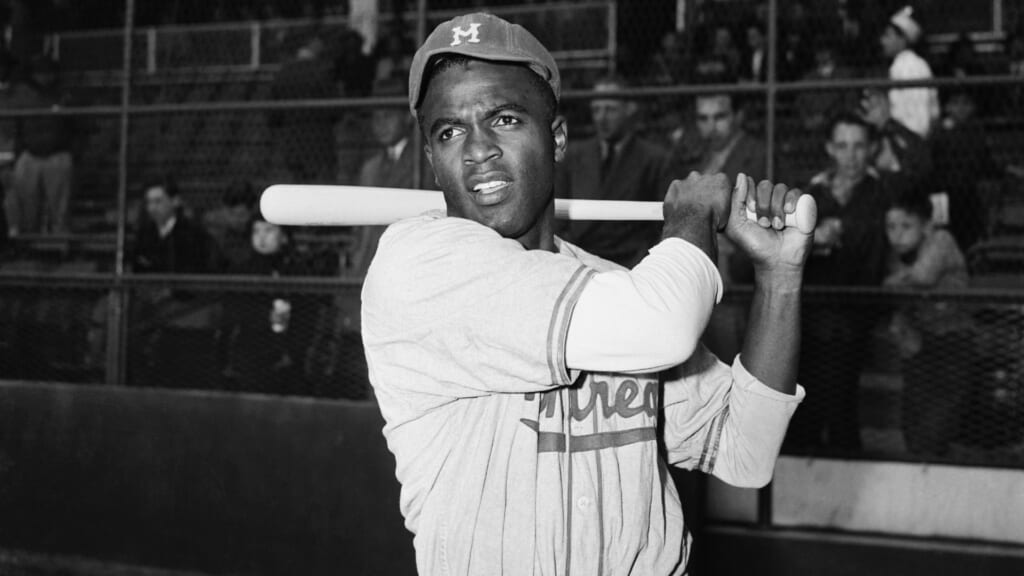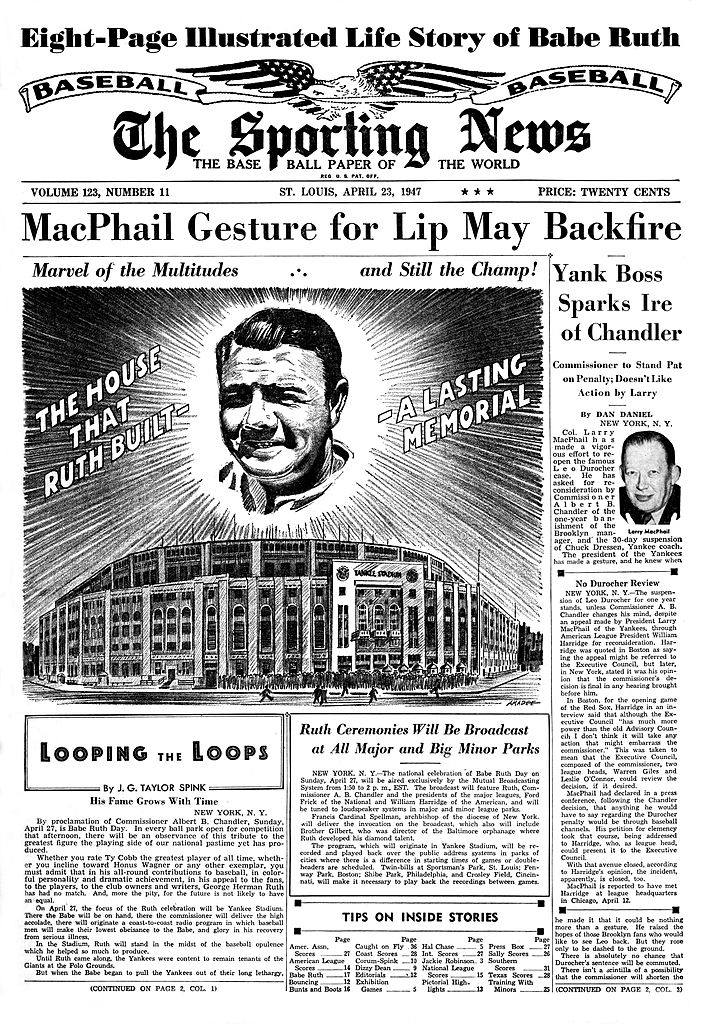75 years ago, media downplayed Jackie Robinson’s historic MLB debut
The disparity in media coverage of Black MLB players has changed since Jackie Robinson's first game, but who leads teams has not.
Seventy-five years ago, Jackie Robinson broke baseball’s color barrier on a chilly spring afternoon in Brooklyn when he started at first base for the Brooklyn Dodgers, one of the most consequential moments in U.S. history. But newspapers didn’t treat it that way.
To American media in April 1947, a much bigger story was “Babe Ruth Day” a dozen days later in the Bronx – a tribute to the star after Americans learned he had undergone a “serious” surgical procedure. As the sport celebrated his transformative career, a weakened, coughing Ruth addressed 58,000 fans at Yankee Stadium before a New York Yankees game against the Washington Senators. It was the year before his death from throat cancer at the age of 53.
These two events – just 15 miles apart in New York City – marked baseball’s mid-century transition from an all-white era where Ruth had been the public face of the sport to an integrated one that Robinson inaugurated in the face of unrelenting abuse from white players, coaches and fans.

In the decades that followed, the ranks of Black players increased dramatically, featuring superstars such as Willie Mays, Hank Aaron, Bob Gibson, Frank Robinson, Ernie Banks, Roy Campanella, Rickey Henderson, Lou Brock, Joe Morgan and Reggie Jackson. But the number of Black players has steadily declined this century. Meanwhile, the sport has struggled to hire Black managers and front-office executives, a failing that Jackie Robinson forcefully and repeatedly criticized in his final years, pressing baseball to do more in this space.
Since then, baseball has made some progress on hiring Black managers, but it’s been halting. Today, only two of MLB’s 30 managers are Black – Dave Roberts of the Los Angeles Dodgers and Dusty Baker of the Houston Astros. Baker did make history this season by becoming the first African American manager to win 2,000 games – and just the 12th manager in MLB history to do so.
Back in 1947, the starkly different ways that the media covered Robinson’s debut and the Babe Ruth event were telling. Both the Washington Post and New York Times featured Babe Ruth Day at the top of the front page. Across the nation, thousands of fans tuned into the celebration of Ruth’s career at major league and minor league ballparks, where the audio was piped in via “nationwide hookup.”
Meanwhile, newspapers gave Robinson’s barrier-breaking debut short shrift. In the next day’s paper, the Post published a generic wire story in the sports section that led with the Dodgers winning their Opening Day game, relegating Robinson’s debut to the second paragraph. The Times’ game story barely mentioned him at all, while a sports column in the paper headlined “Opening Day at Ebbets Field” didn’t reference his debut until the ninth paragraph and leaned into racist stereotypes describing Robinson as a “muscular Negro … who speaks quietly and intelligently when spoken to.”

Ruth had retired in 1935, and in the dozen years since then, he sought to get a job as a big league manager, but race may have played a factor in his failure to land one. In a 2014 interview, his 97-year-old daughter, Julia Ruth Stevens, told the Times the reason no team gave Ruth a chance to manage after he retired was the fear that he would have included African Americans on his roster – at a time when the color barrier was still firmly in place.
“Daddy would have had Blacks on his team, definitely,” she said.
But baseball, like the rest of America, wasn’t ready to integrate in those years, so Black players had to wait until 1947, when Robinson made his debut at Ebbets Field against the Boston Braves. Other Black players followed Robinson to the major leagues that year and over the next decade, but only to a point.
In the 1972 baseball classic “The Boys of Summer,” Roger Kahn wrote that in the early ’50s, baseball had an unwritten “50 percent color line; that is, it was permissible for a major league team to play only four black men out of nine. The ratio, five whites to four blacks, substantiated white supremacy. But to have five blacks playing with four whites supposedly threatened the old order.” Kahn quoted one white player on the Dodgers griping about Black teammates: “They’re taking over.”
But five years after Robinson broke the color barrier, some teams, such as the crosstown Yankees, had zero Black players, and he publicly called them out for failing to integrate.
“I think the members of the Yankees team are fine sportsmen and wonderful gentleman, but there isn’t a single Negro on the team now, and there are very few in the entire Yankee farm system,” he said on an NBC-TV show, according to a Times story on Dec. 1, 1952, about two months after the Yankees beat the Dodgers in the World Series. “It seems to me,” he elaborated in an interview with the paper, “the Yankees front office has used racial prejudice in its dealings with Negro ball players.”
Back then, New York City was home to three baseball teams. The New York Giants had integrated in 1949, when Monte Irvin and Hank Thompson joined the ballclub. But the Yankees remained stubbornly all-white well into the 1950s. In “The Boys of Summer,” Kahn recalled that a Yankees executive told him at the 1952 World Series that he would never allow a Black man to wear a Yankees uniform. “We don’t want that sort of crowd. It would offend boxholders from Westchester to have to sit with” Black people, the executive said, using the N-word – and confirming Robinson’s suspicions.
The Yankees wouldn’t put a Black player on their team until 1955 – the second-to-last year of Robinson’s career – when Elston Howard made his debut.
Black participation in the major leagues grew from that point on. In 1950, just 1.7 percent of players were African American, but the figure reached 8.9 percent in 1960, 14.6 percent in 1970, and 17.4 percent in 1980, according to an analysis by the Society for American Baseball Research.
The figure dropped below 10 percent in 2005 and has stayed below that threshold, for a variety of reasons – such as accessibility and affordability of youth leagues, and the quicker route to pro football and basketball, which don’t have the extensive minor league system that baseball does.
When Robinson died in 1972 – coincidentally, at the same young age of 53 as Ruth – the main issue facing African American participation in baseball was not on the field, but in management. Nine days before his death, MLB honored Robinson at the World Series to commemorate the 25th anniversary of his breaking baseball’s color barrier. But in that intervening quarter-century, no team had hired a Black manager, and Robinson again challenged baseball owners over their lack of progress.
“I am extremely proud and pleased to be here this afternoon,” Robinson said, “but must admit I am going to be tremendously more pleased and more proud when I look at that third base coaching line one day and see a Black face managing in baseball.”
Two years later, the Cleveland Indians named Frank Robinson the sport’s first Black manager after the ’74 season. And when he made his debut the next spring, the New York Times made it front-page news.
Frederic J. Frommer, a writer and sports historian, is the author of several books, including “You Gotta Have Heart: Washington Baseball from Walter Johnson to the 2019 World Series Champion Nationals.”
“TheGrio is FREE on your TV via Apple TV, Amazon Fire, Roku, and Android TV. Please download theGrio mobile apps today!
